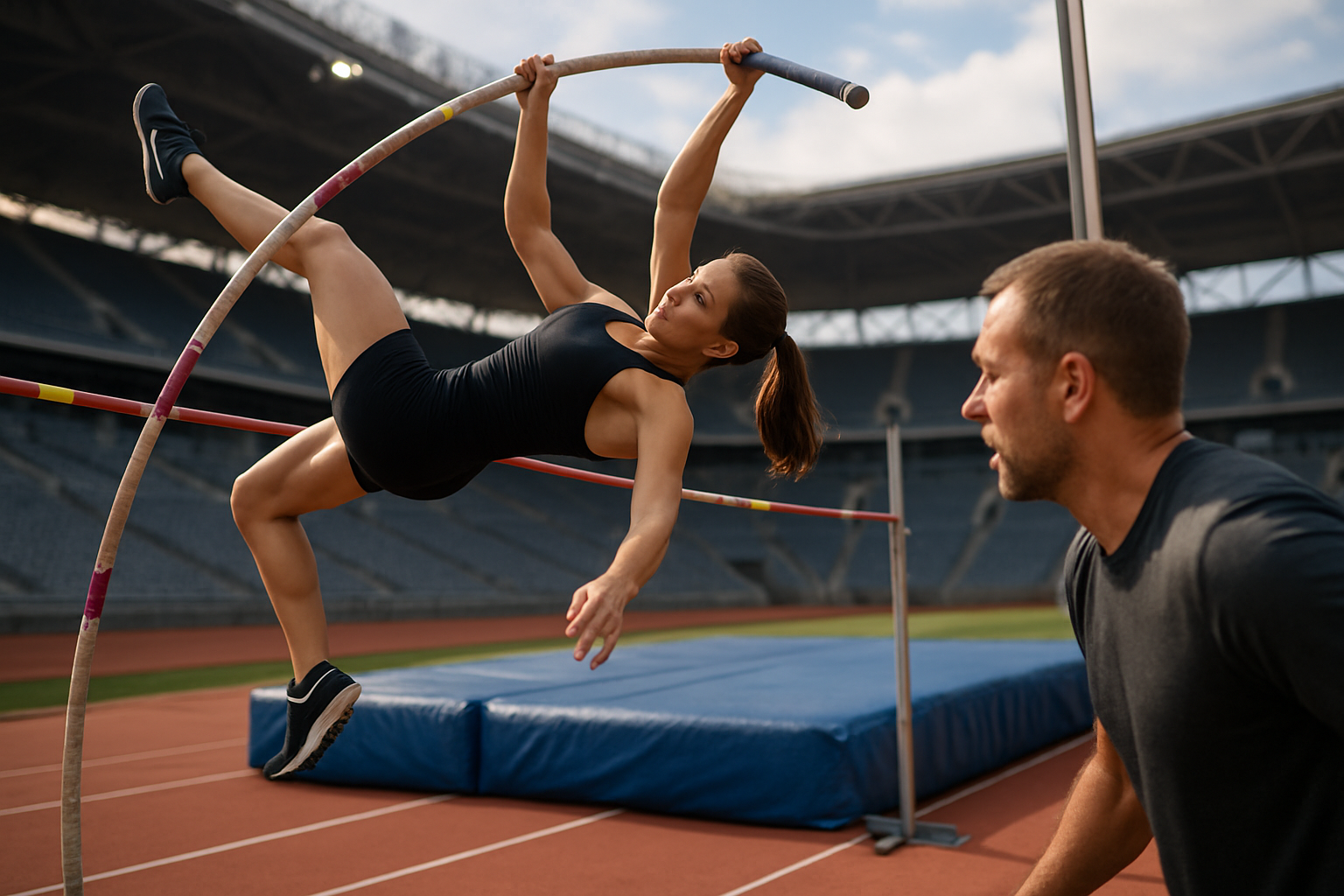Biomechanics of the Perfect Pole Vault: Unraveling Athletic Artistry
The graceful arc of a pole vaulter soaring over the bar is a mesmerizing display of human athleticism. Yet beneath this seemingly effortless flight lies a complex interplay of physics, biomechanics, and years of rigorous training. This article delves deep into the intricate world of pole vaulting, exploring the science behind the perfect jump and the relentless pursuit of new heights in this demanding sport.

The early days of competitive pole vaulting saw athletes using rigid poles made of bamboo or aluminum. However, the sport underwent a revolutionary change in the 1950s with the introduction of flexible fiberglass poles. This innovation allowed vaulters to bend the pole, storing and releasing energy more efficiently, leading to dramatic increases in vault heights.
Today’s elite pole vaulters use carbon fiber poles, carefully tailored to their weight, height, and vaulting style. The world record for men currently stands at 6.21 meters, set by Armand Duplantis in 2022, while the women’s record is 5.06 meters, achieved by Yelena Isinbayeva in 2009.
The Physics of Flight: Understanding the Pole Vault’s Four Phases
A successful pole vault is divided into four distinct phases: the approach, the plant and take-off, the swing and extension, and the fly-away. Each phase requires precise execution and is governed by specific physical principles.
The approach phase is critical for building kinetic energy. Vaulters typically run 40-45 meters, accelerating to speeds of 9-10 meters per second. This phase is all about consistency and rhythm, with athletes fine-tuning their stride pattern to ensure they hit the optimal take-off point.
During the plant and take-off phase, the vaulter converts horizontal velocity into vertical velocity. As the pole is planted into the box, it begins to bend, storing elastic potential energy. The take-off angle is crucial, typically around 15-20 degrees from vertical. This phase involves complex interactions between the vaulter’s body and the pole, with forces reaching up to 4.5 times the athlete’s body weight.
The swing and extension phase is where the stored energy in the pole is converted back into kinetic energy. As the pole unbends, the vaulter executes a series of gymnastic-like movements, swinging up and extending their body to maximize height. This phase requires immense core strength and body awareness.
Finally, in the fly-away phase, the vaulter releases the pole and clears the bar. Here, the athlete must maintain a streamlined position to minimize air resistance and avoid touching the bar. The entire vault, from take-off to landing, typically lasts less than two seconds.
Biomechanical Optimization: The Key to Higher Vaults
Biomechanics plays a crucial role in optimizing pole vault performance. Researchers and coaches use high-speed cameras and motion capture technology to analyze every aspect of a vaulter’s technique. This data helps identify areas for improvement and guides training programs.
One key biomechanical factor is the vaulter’s ability to transfer energy from their run-up to the pole. This transfer is most efficient when the center of mass of the vaulter-pole system moves in a smooth, continuous path. Any sudden changes in direction or velocity result in energy loss.
Another critical aspect is the timing of the pole bend and recoil. The vaulter must coordinate their actions with the pole’s movement to maximize energy return. This requires precise muscular coordination and body positioning throughout the vault.
The angle of the body at take-off and during the swing phase also significantly impacts performance. An optimal take-off angle allows for maximum energy transfer to the pole, while proper body positioning during the swing helps in achieving greater height.
The Role of Strength and Flexibility in Pole Vaulting
While technique is paramount, the physical attributes of strength and flexibility are equally crucial for pole vaulters. The sport demands a unique combination of power, agility, and gymnastic ability.
Upper body strength is essential for controlling the pole during the plant and swing phases. Vaulters need powerful shoulders, arms, and grip strength to manage the forces involved in bending and controlling the pole. Core strength is vital for maintaining body position and executing the complex movements required during the vault.
Lower body strength, particularly in the legs and hips, is crucial for generating speed during the approach and power during the take-off. Plyometric exercises are often incorporated into training regimens to develop explosive power.
Flexibility, especially in the shoulders, hips, and back, allows vaulters to achieve optimal positions during the vault. Gymnastic-style training is often used to develop the necessary flexibility and body awareness.
The Mental Game: Psychology of Pole Vaulting
The psychological aspects of pole vaulting are often overlooked but are crucial for success. The sport requires immense mental fortitude, as vaulters must overcome the natural fear of launching themselves several meters into the air.
Visualization techniques are commonly used by pole vaulters to mentally rehearse their jumps. This mental practice helps reinforce proper technique and build confidence. Many vaulters develop pre-jump routines to help focus their minds and manage anxiety.
The ability to handle pressure is also vital, as competitive vaulting often comes down to clearing critical heights under intense scrutiny. Mental training techniques, such as mindfulness and stress management, are increasingly incorporated into vaulters’ training programs.
Technological Advancements in Pole Vaulting
Technology continues to play a significant role in advancing pole vaulting performance. Modern poles are engineered with precise flex characteristics to match individual vaulters. Computer simulations are used to optimize pole design and predict performance under various conditions.
Wearable technology and sensors are now being used to provide real-time feedback on an athlete’s technique. These devices can measure parameters such as approach speed, take-off angle, and pole bend, allowing for immediate adjustments during training.
Video analysis software has become more sophisticated, enabling coaches to provide detailed feedback on every aspect of a vault. Some systems use artificial intelligence to automatically identify areas for improvement in an athlete’s technique.
Training Methodologies for Elite Pole Vaulters
The training regimen for elite pole vaulters is multifaceted, combining technical practice, strength training, and cardiovascular conditioning. A typical training week might include:
-
Technical sessions focusing on specific aspects of the vault, such as the approach, plant, or swing.
-
Strength training targeting key muscle groups, including Olympic lifts and plyometrics.
-
Sprint workouts to improve approach speed and acceleration.
-
Gymnastic training to enhance body awareness and flexibility.
-
Mental training sessions for visualization and stress management.
Periodization is crucial in pole vault training, with different phases focusing on building strength, improving technique, and peaking for competitions. Many vaulters also cross-train in other sports or disciplines to develop overall athleticism and prevent burnout.
Injury Prevention and Management in Pole Vaulting
The high-impact nature of pole vaulting puts athletes at risk for various injuries. Common issues include shoulder injuries from the forces exerted during the plant and swing, back injuries from hyperextension, and ankle injuries from landings.
Injury prevention strategies focus on proper technique, gradual progression in training intensity, and comprehensive strength and flexibility programs. Core stability exercises are particularly important for protecting the back and improving overall performance.
Recovery techniques such as massage, hydrotherapy, and active recovery sessions are integral to maintaining an athlete’s health and performance over a long season. Nutrition and sleep management are also crucial aspects of injury prevention and overall athletic development.
The Future of Pole Vaulting: Pushing the Limits of Human Performance
As technology and training methodologies continue to advance, the future of pole vaulting looks promising. Some experts predict that we may see vaults approaching 7 meters for men and 6 meters for women in the coming decades.
Research into biomechanics and materials science may lead to even more efficient poles and techniques. Virtual reality training tools could allow vaulters to practice in simulated environments, potentially accelerating skill acquisition and reducing injury risk.
Genetic research and personalized training programs based on an athlete’s DNA profile may help identify and nurture future pole vaulting talents. However, this raises ethical questions about the role of genetics in sport and the potential for genetic enhancement.
The Artistry and Science of Pole Vaulting
Pole vaulting stands as a testament to human ingenuity and physical prowess. It is a sport that demands a perfect blend of speed, strength, technique, and courage. As we’ve explored, the biomechanics of the perfect pole vault involve a complex interplay of physics, physiology, and psychology.
From its ancient origins to its modern Olympic glory, pole vaulting continues to captivate athletes and spectators alike. As technology and training methods evolve, we can expect to see even more extraordinary performances in the future. Yet, at its core, pole vaulting remains a deeply human endeavor—a beautiful fusion of athletic artistry and scientific precision.
The pursuit of the perfect vault drives athletes to push the boundaries of what’s possible, inspiring us all with their gravity-defying feats. As we look to the future of this exhilarating sport, one thing is certain: the sky’s the limit for pole vaulting’s continued evolution and the heights its practitioners will achieve.





